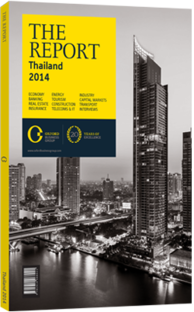OBG talks to Kittiratt Na Ranong, Deputy Prime Minister and Minister of Finance

Interview: Kittiratt Na Ranong
To what extent will the termination of US monetary stimulus impact Thailand’s economic outlook?
KITTIRATT NA RANONG: If the US Federal Reserve decides to taper its quantitative easing programme, the effect would be twofold. First, the decision would reflect regained strength of the US economy. As the US economy contributes almost 25% of world GDP, such recovery would positively affect the global economy, as well as the Thai economy through trade, investment, and tourism over the longer term. However, in the short run, the timing and the degree of tapering would certainly influence the flow of funds and the exchange rate, which would pose an additional challenge in terms of volatilities. This dynamic became apparent in August 2013, as a number of economies across Asia experienced significant capital outflows and currency devaluation over concern about the tapering of US stimulus measures.
What measures can help offset the negative impacts of China’s slowdown on Thailand’s economic growth?
KITTIRATT: In recent years, China has played a crucial role in the economic development of Asia as well as Thailand. While the China factor has sheltered us during the recent global economic slowdown, we are undoubtedly more dependent on China’s growth. To mitigate the negative impacts of China’s slowdown, Thailand attempts to diversify our trade and investment toward new emerging markets such as our neighbouring countries in ASEAN and Africa. Additionally, we have plans to rebalance the economy in terms of domestic versus external reliance through several income-promoting schemes to support and strengthen our domestic economy and through infrastructure investment.
What impact will the government’s infrastructure investment plan have on the economy?
KITTIRATT: Since the Asian crisis of 1997-98, our infrastructure investments have lagged. The logistics bottleneck has resulted in the deterioration of our competitive positioning. As such, this administration has put forward a BT2 ($65.8m) infrastructure investment plan over the next seven years. Specifically, our plan covers a dual-track railway, high-speed train, port improvement, and upgrades of Customs points with the aim to improve the efficiency of our logistics network as well as to spread prosperity throughout Thailand and the region.
As for the benefits for the economy, during the construction period infrastructure investment is predicted to further stimulate our real GDP level on an average of 1% per year. After completion, the infrastructure investment is estimated to help reduce the logistics cost by 2% of GDP, lowering energy consumption by BT100bn ($3.29bn) per year, reducing transportation time by as much as one-third, and ultimately transforming the way we live and do businesses.
How would you qualify the performance of Thailand’s economic stability framework for 2013?
KITTIRATT: The main purpose of our economic stability framework is to provide broad guidance in monitoring our economic and financial conditions in order to ensure both growth and stability, especially in a time of global volatility. The framework for 2013 specifically assigns each stability objective to a corresponding agency, which would be expected to achieve both short-term and long-term targets through the utilisation of fiscal or competitiveness-enhancement measures.
The coordination among these agencies is crucial to the overall performance of Thailand’s economic stability. Up to now, the integrated coordination among key government agencies has led to a synchronised policy execution that permits the Thai economy to stay steadily on course towards sustainable economic development. Currently, Thailand’s economy is resilient in terms of risk from volatilities in the global economy, as indicated by the country’s low unemployment and low inflation, and high international reserves of $170.8bn at the end of June 2013. In addition, Thailand’s banking sector is strong with the high capital ratio of 16.1%.
These could cushion against capital flow reversal.
You have reached the limit of premium articles you can view for free.
Choose from the options below to purchase print or digital editions of our Reports. You can also purchase a website subscription giving you unlimited access to all of our Reports online for 12 months.
If you have already purchased this Report or have a website subscription, please login to continue.

